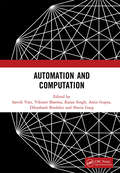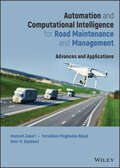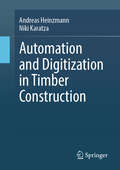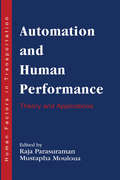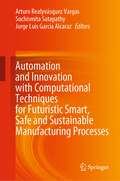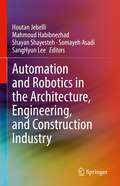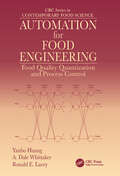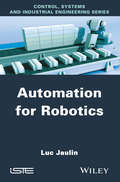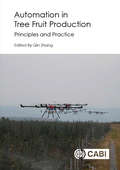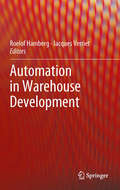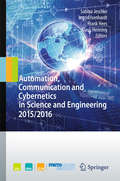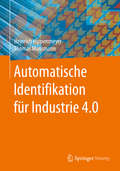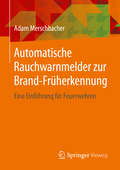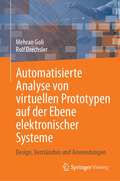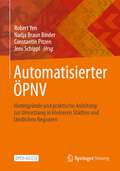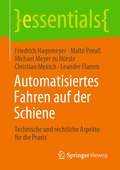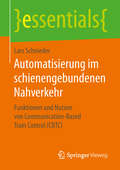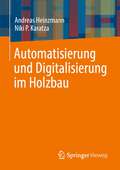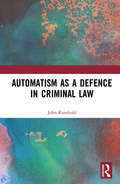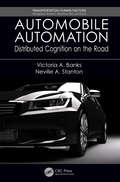- Table View
- List View
Automation and Computation: Proceedings of the International Conference on Automation and Computation, (AutoCom 2022), Dehradun, India
by Karan Singh Amit Gupta Satvik Vats Sharma Vikrant Dibyahash Bordoloi Navin GargThe proceedings of the International Conference on Automation and Computation 2022 (AUTOCOM-22) consist of complete research articles that were presented at the conference. Each of the research articles was double-blind reviewed by the experts of the corresponding domain. The book contains a blend of problems and respective solutions related to computer-based automation & computation to highlight the recent technological developments in computer-based automation. It serves as an environment for researchers to showcase the latest research results on Data Science & Engineering, Computing Technologies, Computational Intelligence, Communication & Networking, Signal & Image Processing, Intelligent Control Systems & Optimization, Robotics and Automation, Power, Energy & Power Electronics, Healthcare & Computation, AI for human interaction, etc. It aims to give deep insight into the current trends of research in science and technology and shall introduce the reader to the new problems and respective approaches toward the solution and shall enlighten the researchers, students and academicians about the research being carried out in the field.
Automation and Computational Intelligence for Road Maintenance and Management: Advances and Applications
by Amir H. Gandomi Hamzeh Zakeri Fereidoon Moghadas NejadAutomation and Computational Intelligence for Road Maintenance and Management A comprehensive computational intelligence toolbox for solving problems in infrastructure management In Automation and Computational Intelligence for Road Maintenance and Management, a team of accomplished researchers delivers an incisive reference that covers the latest developments in computer technology infrastructure management. The book contains an overview of foundational and emerging technologies and methods in both automation and computational intelligence, as well as detailed presentations of specific methodologies. The distinguished authors emphasize the most recent advances in the maintenance and management of infrastructure robotics, automated inspection, remote sensing, and the applications of new and emerging computing technologies, including artificial intelligence, evolutionary computing, fuzzy logic, genetic algorithms, knowledge discovery and engineering, and more. Automation and Computational Intelligence for Road Maintenance and Management explores a universal synthesis of the cutting edge in parameters and indices to evaluate models. It also includes: Thorough introductions to management science and the latest methods of automation and the structure and framework of automation and computing intelligence Comprehensive explorations of advanced image processing techniques, recent advances in fuzzy, and diagnosis automation Practical discussions of segmentation and fragmentation and different types of features and feature extraction methods In-depth examinations of methods of classification along with various developed methodologies and models of quantification, evaluation, and indexing in automation Perfect for postgraduate students in road and transportation engineering, evaluation, and assessment, Automation and Computational Intelligence for Road Maintenance and Management will also earn a place in the libraries of researchers interested in or working with the evaluation and assessment of infrastructure.
Automation and Digitization in Timber Construction
by Andreas Heinzmann Niki KaratzaIn this work, the authors provide an overview of the manufacturing principles possible in timber construction, such as batch, line, and cell production, and assess these approaches in relation to the requirements of different timber construction companies. In a further step, technological possibilities for all relevant processes in timber construction production are discussed. Due to the authors' strong ties to science and research, the technological approaches are analyzed for their potential strengths and weaknesses, offering the reader a neutral perspective, independent of manufacturer arguments. The authors not only address key questions that arise regarding new construction or expansion of production, but also present solutions that help optimize and digitize the entire process, from order generation to the completion of a construction project. A central guiding principle of the authors is the realization that optimizing a single area in production cannot fully harness the potential of the entire timber construction process.
Automation and Human Performance: Theory and Applications (Human Factors In Transportation Ser.)
by Raja Parasuraman and Mustapha MoulouaThere is perhaps no facet of modern society where the influence of computer automation has not been felt. Flight management systems for pilots, diagnostic and surgical aids for physicians, navigational displays for drivers, and decision-aiding systems for air-traffic controllers, represent only a few of the numerous domains in which powerful new automation technologies have been introduced. The benefits that have been reaped from this technological revolution have been many. At the same time, automation has not always worked as planned by designers, and many problems have arisen--from minor inefficiencies of operation to large-scale, catastrophic accidents. Understanding how humans interact with automation is vital for the successful design of new automated systems that are both safe and efficient. The influence of automation technology on human performance has often been investigated in a fragmentary, isolated manner, with investigators conducting disconnected studies in different domains. There has been little contact between these endeavors, although principles gleaned from one domain may have implications for another. Also, with a few exceptions, the research has tended to be empirical and only theory-driven. In recent years, however, various groups of investigators have begun to examine human performance in automated systems in general and to develop theories of human interaction with automation technology. This book presents the current theories and assesses the impact of automation on different aspects of human performance. Both basic and applied research is presented to highlight the general principles of human-computer interaction in several domains where automation technologies are widely implemented. The major premise is that a broad-based, theory-driven approach will have significant implications for the effective design of both current and future automation technologies. This volume will be of considerable value to researchers in human
Automation and Human Solidarity
by Bill JordanThis book provides a detailed analysis of the economic and political implications of the introduction of Artificial Intelligence and Robotics into the service sector of economies that have so far relied on service jobs to sustain levels of employment. It examines how reliance on coercive measures for enforcing low-paid service work attempts to postpone this third Industrial Revolution, and analyses the struggles that must still take place if we are to achieve a future of freedom and social justice for all. While automation and globalisation have made human solidarities of traditional kinds more difficult to sustain, they have also made new kinds possible. Experiments in social policy, and especially the pilot projects with unconditional Universal Basic Incomes, offer a possible model for a new kind of society. The author argues that it is politics which will determine whether we can achieve these new human solidarities.
Automation and Innovation with Computational Techniques for Futuristic Smart, Safe and Sustainable Manufacturing Processes
by Arturo Realyvásquez Vargas Jorge Luis García Alcaraz Suchismita SatapathyThis book explores sustainability and innovation in manufacturing, encompassing three distinct parts. The first section delves into Sustainability in Manufacturing, where it analyzes topics like intelligent manufacturing, Industry 4.0 challenges, structural equation modeling for social sustainability, barriers to intelligent manufacturing systems, and critical success factors in Six Sigma deployment. The second part of the book, comprising Chapters 6-11, focuses on Ergonomics and Safety in manufacturing, examining cases related to health issues caused by factors like noise, high-temperature working conditions, ergonomic posture, and design attributes for ergonomic products. Lastly, Part III, consisting of Chapters 12-14, explores computational techniques applied in manufacturing, addressing issues such as vegetable waste in India, technology transfer models for university-industry collaboration, and the application of System Dynamics in safety management systems. Together, these chapters provide a comprehensive overview of sustainability, ergonomics, safety, and computational techniques in the manufacturing industry.
Automation and Robotics in the Architecture, Engineering, and Construction Industry
by Somayeh Asadi Houtan Jebelli Mahmoud Habibnezhad Shayan Shayesteh SangHyun LeeAutomation and Robotics in the Architecture, Engineering, and Construction Industry provides distinct and unified insight into current and future construction robotics, offering readers a comprehensive perspective for constructing a road map and illuminating improvements for a successful transition towards construction robotization. The book covers the fundamentals and applications of robotics, autonomous vehicles, and human-perceptive machines at construction sites. Through theoretical and experimental analyses, it examines the potential of robotics and automated systems for current and future fieldwork operations and identifies the factors that determine their implementation pace, adoption scale, and ubiquity throughout the industry. The book evaluates the technical, societal, and economic aspects of adopting robots in construction, both as standalone and collaborative systems, which in return can afford the opportunity to investigate these AI-enabled machines more systematically.
Automation for Food Engineering: Food Quality Quantization and Process Control (Contemporary Food Science)
by Yanbo Huang A. Dale Whittaker Ronald E. LaceyAutomation for Food Engineering introduces the frameworks, methods, designs, algorithms, tests, and implementation of data acquisition, analysis, modeling, prediction, and control in automation for food engineering. Using numerous examples and case studies from food engineering projects, the book introduces basic methods systematically and describes advanced techniques, such as medical imaging, mathematical analysis, and statistical modeling, which have proven successful in food engineering. The authors use the characteristics of food processes to describe concepts and employ data from food engineering applications to explain the methods.
Automation for Robotics
by Luc JaulinIn order to enable a better understanding of the key concepts of automation, this book develops the fundamental aspects of the field while also proposing numerous concrete exercises and their solutions. The theoretical approach that it presents fundamentally uses the state space and makes it possible to process general and complex systems in a simple way, involving several switches and sensors of different types. This approach requires the use of developed theoretical tools such as linear algebra, analysis and physics, generally taught in preparatory classes for specialist engineering courses.heoretical tools such as linear algebra, analysis and physics, generally taught in preparatory classes for specialist engineering courses.
Automation in Construction toward Resilience: Robotics, Smart Materials and Intelligent Systems (Resilience and Sustainability in Civil, Mechanical, Aerospace and Manufacturing Engineering Systems)
by Izuru Takewaki Shaofan Li Paolo Gardoni Ehsan Noroozinejad Farsangi Paulo B. Lourenço Eleni Chatzi Mohammad Noori Yang, Tony T.Y.While the word "automation" may conjure images of robots taking over jobs, the reality is much more nuanced. In construction, for instance, automation is less likely to diminish employment opportunities than it is to increase productivity. Indeed, automation alongside the global need for new and updated infrastructure and better and more affordable housing can help shape the direction of the construction industry. The key will be anticipating and preparing for the shift, in part by developing new skills in the current and future workforce. This book presents all aspects of automation in construction pertaining to the use of information technologies in design, engineering, construction technologies, and maintenance and management of constructed facilities. The broad scope encompasses all stages of the construction life cycle from initial planning and design, through the construction of the facility, its operation, and maintenance, to the eventual dismantling and recycling of buildings and engineering structures. Features: Examines Building Information Management systems, allowing on-site execution of construction more efficient, and for project teams to eliminate mistakes and better coordinate the workforce Presents the latest information on the automation of modular construction, production in factories, including 3-D printing of components such as facades, or even load-bearing and essential components
Automation in Textile Machinery: Instrumentation and Control System Design Principles
by L. Kumar M Senthil KumarAutomation is the use of various control systems for operating equipment such as machinery and processes. In line, this book deals with comprehensive analysis of the trends and technologies in automation and control systems used in textile engineering. The control systems descript in all chapters is to dissect the important components of an integrated control system in spinning, weaving, knitting, chemical processing and garment industries, and then to determine if and how the components are converging to provide manageable and reliable systems throughout the chain from fiber to the ultimate customer. Key Features: • Describes the design features of machinery for operating various textile machineries in product manufacturing • Covers the fundamentals of the instrumentation and control engineering used in textile machineries • Illustrates sensors and basic elements for textile automation • Highlights the need of robotics in textile engineering • Reviews the overall idea and scope of research in designing textile machineries
Automation in Tree Fruit Production: Principles and Practice
by Qin ZhangAutomation in agriculture is made possible by the integration of advanced agricultural technology and precision agriculture management. This book, uniquely, will focus on applications of automation to the important industry of tree fruit production. Written by experts in agricultural automation technology from around the world, chapters in this book cover topics such as automated tree fruit production systems, plant stress sensing and high-throughput phenotyping in precision horticulture, the economics of automation in tree fruit production, light interception sensing systems for canopy management, precision irrigation and water management, precision technologies for pest and disease management, opportunities for the application of robotics in tree fruit production, and the mechanical harvesting and handling of fruit crops. The book is a representative, concise overview of the variety of technologies currently being applied to tree fruit crops around the world and the challenges faced by engineers and farmers that these technologies raise. It is aimed at researchers and graduate students of agriculture systems, agricultural and biological engineering, crop and soil sciences, horticulture, precision agriculture, and other relevant disciplines. It will also be of use to agriculture consultants, engineers, and other professionals such as agricultural equipment manufacturers and management professionals who use precision agriculture technologies. Key Features: - Takes a systematic approach to how to apply precision and automation technologies to fruit production. - Combines the disciplines of economics, horticulture, and engineering. - Illustrated by case studies throughout describing actual applications of automation technology.
Automation in Tree Fruit Production: Principles and Practice
by Qin ZhangThe technology that allows automation in agriculture is rapidly developing and being applied to wide variety of key crops. This book focuses on automation in tree fruit crops worldwide. It covers topics such as automated tree fruit production systems, plant stress sensing and high-throughput phenotyping in precision horticulture, the economics of automation in tree fruit production, light interception sensing systems for canopy management, precision irrigation and water management, precision technologies for pest and disease management, opportunities for the application of robotics in tree fruit production, and the mechanical harvesting and handling of fruit crops.
Automation in Warehouse Development
by Roelof Hamberg Jacques VerrietThe warehouses of the future will come in a variety of forms, but with a few common ingredients. Firstly, human operational handling of items in warehouses is increasingly being replaced by automated item handling. Extended warehouse automation counteracts the scarcity of human operators and supports the quality of picking processes. Secondly, the development of models to simulate and analyse warehouse designs and their components facilitates the challenging task of developing warehouses that take into account each customer's individual requirements and logistic processes. Automation in Warehouse Development addresses both types of automation from the innovative perspective of applied science. In particular, it describes the outcomes of the Falcon project, a joint endeavour by a consortium of industrial and academic partners. The results include a model-based approach to automate warehouse control design, analysis models for warehouse design, concepts for robotic item handling and computer vision, and autonomous transport in warehouses. Automation in Warehouse Development is targeted at both academic researchers and industrial practitioners. It provides state-of-the art research on warehouse automation and model-based warehouse design. These topics have been addressed from a systems engineering perspective by researchers from different disciplines including software, control, and mechanical engineering, with a clear focus on the industrial applications of their research.
Automation, Communication and Cybernetics in Science and Engineering 2015/2016
by Sabina Jeschke Ingrid Isenhardt Frank Hees Klaus HenningAutomation, Communication and Cybernetics in Science and Engineering 2015/2016
Automation, Innovation and Economic Crisis: Surviving the Fourth Industrial Revolution (Routledge Studies in the Economics of Innovation)
by Jon-Arild JohannessenThe fourth industrial revolution is developing globally, with no geographical centre. It is also taking place at enormous speed. This development will shape the workplaces of the future, which will be entirely different from the workplaces created by the first, second and third industrial revolutions. Industry created the industrial worker. The knowledge society will create a new type of "industrial worker", the knowledge worker. While the third industrial revolution was concerned with the digitalization of work, in the fourth industrial revolution, robots will bring about the informatization of work. Many of these robots will be systematically connected, such that they can obtain updated information and learn from their own and others’ mistakes. The way we work, where we work, what we work on, and our relationships with our colleagues and employers are all in a state of change. The workplace of the future will not necessarily be a fixed geographical location, but may be geographically distributed and functionally divided. In his book, Jon-Arild Johannessen argues that a "perfect" social storm occurs when inequality grows at a catastrophic rate, unemployment increases, job security is threatened for a growing number and robotization takes over even the most underpaid jobs. Thus, the ingredients for a perfect social storm will be brought forward by cascades of innovations that will most likely lead to economic and social crises and he argues that it is reasonable to assume that it will only take a small spark for this social storm to develop into a social revolution.
Automatische Identifikation für Industrie 4.0
by Heinrich Hippenmeyer Thomas MoosmannDie Autoren gehen in diesem Buch darauf ein, welche Herausforderungen mit "Industrie 4. 0" auf Industriepraktiker zukommen. Wie und mit welchen Zielsetzungen können Entwicklungen in mittelständischen Unternehmen aufgegriffen werden? Die Geräte zur automatischen Identifikation als Teil der Prozesssteuerung und Systemplanung der Intralogistik, zur Einbindung in das Netzwerk im Unternehmen und mit Partnern, sind Kumulationspunkte vieler Probleme in kleinen und mittelständischen Unternehmen. Diesen wird dargelegt wo und wie in den automatisierten Unternehmensbereichen Schritte zur "digitalen" Fabrik bereits vollzogen wurden und wie die Einbindung der betrieblichen Intralogistik in das firmenweite Netzwerk und damit in das ERP-System erfolgen kann.
Automatische Rauchwarnmelder zur Brand-Früherkennung: Eine Einführung für Feuerwehren
by Adam MerschbacherDieses Buch soll dazu beitragen, dass Rauchmelder durch Auswahl und Montage zuverlässig Schäden und Rauchopfer, sowie Falschmeldungen vermeiden. Außerdem schafft es Klarheit darüber, wer für was verantwortlich ist.
Automatisierte Analyse von virtuellen Prototypen auf der Ebene elektronischer Systeme: Design, Verständnis und Anwendungen
by Rolf Drechsler Mehran GoliDieses Buch beschreibt eine Reihe von SystemC-basierten Analysemethoden für virtuelle Prototypen, einschließlich Entwurfsverständnis, Verifikation, Sicherheitsvalidierung und Entwurfsraumuntersuchung. Der Leser erhält einen Überblick über die neuesten Forschungsergebnisse auf dem Gebiet der Electronic Design Automation (EDA) auf der elektronischen Systemebene (ESL). Die besprochenen Methoden ermöglichen es den Lesern, wichtige Aufgaben und Anwendungen im Entwurfsprozess leicht zu bewältigen.Übersetzt mit www.DeepL.com/Translator (kostenlose Version)
Automatisierter ÖPNV: Hintergründe und praktische Anleitung zur Umsetzung in kleineren Städten und ländlichen Regionen
by Nadja Braun Binder Jens Schippl Robert Yen Constantin PitzenDieses Open-Access-Handbuch versteht sich als praktisches Hilfsmittel für den gezielten Einsatz eines automatisierten ÖPNV auf dem Weg zur Mobilitätswende. Es richtet sich in erster Linie an Entscheidungsträger, Verwaltungen kleinerer und größerer Kommunen sowie an Verkehrsbetriebe. Das Handbuch vermittelt der Leserin und dem Leser einen umfassenden Überblick über verschiedene Entwicklungslinien des automatisierten Fahrens sowie über die damit verbundenen Chancen und Risiken für Mobilität und Gesellschaft. Die Autorinnen und Autoren verdeutlichen sehr anschaulich, dass die Chancen des automatisierten Fahrens vor allem in der Ergänzung oder Erweiterung des ÖPNV liegen. Davon ausgehend adressiert das Buch sehr praxisnah und umsetzungsorientiert alle wesentlichen Fragestellungen, die vor dem Start eines Pilotprojekts zur Einführung eines automatisierten ÖPNV bedacht werden sollten. Der Fokus liegt auf den oft unberücksichtigten ländlichen Räumen bzw. jenen Räumen größerer Städte und Regionen, die heute von den Verkehrsbetrieben und -verbünden nicht oder nur sehr unzureichend versorgt werden. Den Herausgebern und der Herausgeberin ist das Anliegen, die Mobilitätswende so gut und rasch als möglich zu schaffen, sowie das Wissen um die herausragende Rolle des ÖPNV als kollektives Verkehrsmittel gemein. Die Autorinnen und Autoren stammen aus der Wissenschaft und aus der täglichen Planungs- und Beratungspraxis. Es ist ihnen in hervorragender Weise gelungen, eine sowohl systemische wie auch sehr lösungsorientierte Sicht auf die oft komplexe Aufgabe der Mobilitätswende zu eröffnen und die Rolle zu beschreiben, die ein automatisierter ÖPNV bei der Mobilitätswende spielen könnte.
Automatisiertes Fahren auf der Schiene: Technische und rechtliche Aspekte für die Praxis (essentials)
by Friedrich Hagemeyer Malte Preuß Michael Meyer zu Hörste Christian Meirich Leander FlammGetrieben durch akuten Fachkräftemangel besteht im Fernbahnbetrieb Bedarf an einer durchgreifenden Automatisierung unter Einsatz modernster Technologien. Chancen für eine wirtschaftliche Umsetzung bietet ein hochassistierter Betrieb, mit dem die Anforderungen an die Ausbildung von Triebfahrzeugführern radikal reduziert werden. In der vorliegenden Analyse werden die derzeitigen Tätigkeitsfelder eines Triebfahrzeugführers denen in einem vollautomatischen bzw. hochassistierten Bahnbetrieb hinsichtlich der rechtlichen und betrieblichen Randbedingungen gegenübergestellt. Dabei stellt der vollautomatische Bahnbetrieb in der regulatorischen Fragestellung den komplexesten Betrachtungsfall dar.
Automatisierung im schienengebundenen Nahverkehr: Funktionen und Nutzen von Communication-Based Train Control (CBTC) (essentials)
by Lars SchniederInnerstädtische Schienenverkehrssysteme stoßen bei steigender Verkehrsnachfrage zunehmend an ihre Grenzen. Die Sicherheit und die Leistungsfähigkeit dieser Verkehrssysteme werden wesentlich durch die eingesetzte Leit- und Sicherungstechnik bestimmt. Eine Ausweitung des Verkehrsangebots erfordert leistungsfähige signaltechnische Systeme, die als Communications-Based Train Control (CBTC) bezeichnet werden. Lars Schnieder stellt in diesem essential die Systemumgebung dar, in die sich die CBTC-Systeme in Nahverkehrsunternehmen integrieren. Darüber hinaus leitet er her, welchen Beitrag die einzelnen Sicherungsfunktionen von CBTC-Lösungen zur Gefährdungsbeherrschung leisten. Auf dieser Grundlage zeigt der Autor, wie mit zunehmender Automatisierung sukzessive ein höherer Funktionsumfang von technischen Systemen übernommen wird. Zum Abschluss diskutiert er an CBTC-Systeme gestellte nicht-funktionale Anforderungen wie Sicherheit, Verfügbarkeit, Leistungsfähigkeit und Wirtschaftlichkeit.Der Autor: Dr.-Ing. Lars Schnieder verantwortet in einer Software-Entwicklungsfirma das Geschäftsfeld Sicherheitsbegutachtung. Er ist international als anerkannter Sachverständiger für Zugsicherungsanlagen tätig.
Automatisierung und Digitalisierung im Holzbau
by Andreas Heinzmann Niki P. KaratzaDie Autoren geben im vorliegenden Werk einen Überblick über die im Holzbau möglichen Fertigungsprinzipien wie Takt,- Linien- und Zellenfertigung und bewerten die Ansätze in Bezug auf die Anforderungen unterschiedlicher Holzbaubetriebe. In einem weiteren Schritt werden technologische Möglichkeiten für alle relevanten Prozesse in einer Holzbauproduktion erörtert. Durch den starken Bezug der Autoren zu Wissenschaft und Forschung werden die Technologieansätze auf ihre möglichen Stärken und Schwachpunkte analysiert und dadurch wird dem Leser ein neutraler Blick, unabhängig von Argumenten der Hersteller, ermöglicht. Die Autoren diskutieren nicht nur wichtige Fragestellungen, die in Bezug auf einen Neubau oder einer Erweiterung der Produktion zu Tage treten, sondern geben auch Lösungsansätze weiter, die dabei helfen den gesamten Prozess von der Auftragsgenerierung bis hin zur Abnahme eines Bauvorhabens zu optimieren und zu digitalisieren. Die Tatsache, dass durch das Optimieren eines Teilbereichs in der Produktion das mögliche Potential im gesamten Holzbauprozess nicht ausgeschöpft werden kann, ist dabei die zentrale Leitlinie des Autorenduos.
Automatism as a Defence
by John RumboldAutomatism is a notoriously difficult subject for law students, lawyers and judges. This book explores the science and medicine of sleep disorders and examines how the criminal process deals with such disorders when presented as a defence. It systematically examines the legal doctrines involved, and their implications for the use of the evidence key to establishing automatism, while also exploring the medical conditions that can cause automatism (particularly epilepsy, sleepwalking and diabetes). This book is a valuable resource for law students, lawyers, judges and expert witnesses.
Automobile Automation: Distributed Cognition on the Road (Transportation Human Factors)
by Neville A. Stanton Victoria A. BanksIncreasing levels of driving automation has changed the role of the driver from active operator to passive monitor. However, Systems Design has been plagued by criticism for failing to acknowledge the new role of the driver within the system network. To understand the driver's new role within an automated driving system, the theory of Distributed Cognition is adopted. This approach provides a useful framework for the investigation of allocation of function between multiple agents in the driving system. A Systems Design Framework has been developed that outlines how the Distributed Cognition paradigm can be applied to driving using both qualitative and quantitative research methodologies.
